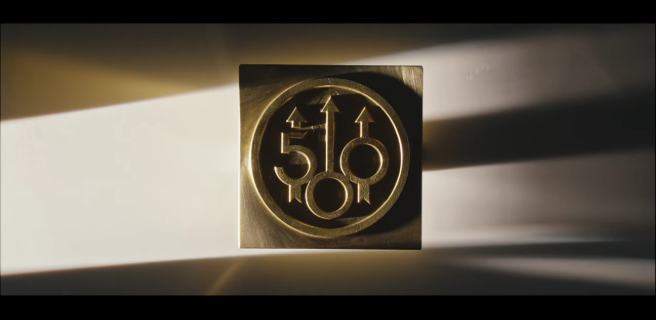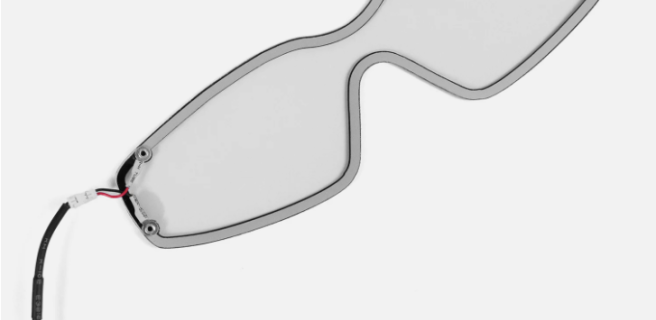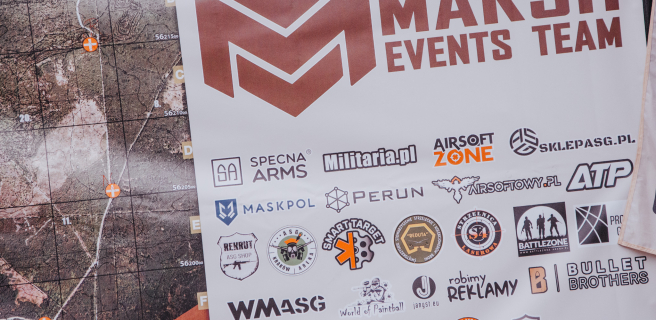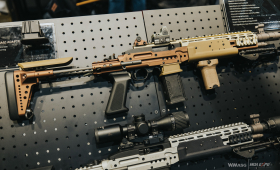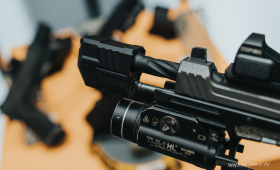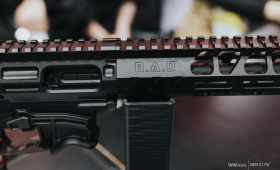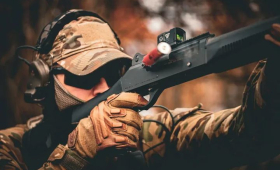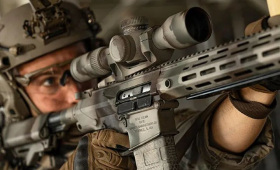Introduction
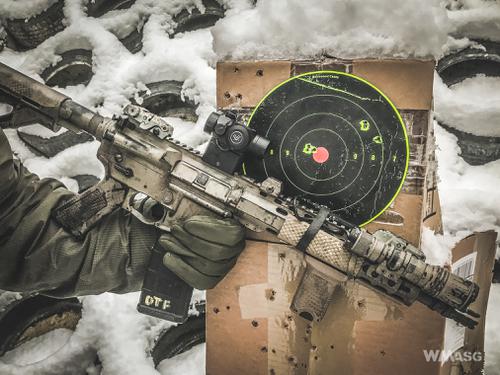
Vortex is known from manufacturing high-quality, yet affordable scopes and collimators for firearms. The rest of the company's offer are bioculars, rangefinders and observation telescopes. Vortex focuses on manufacturing of optics and is not just a part of the company's activity. This translates into continuous development and improvement of the offered products. An example of this is SPARC II, which is an improved version of the SPARC I collimator.

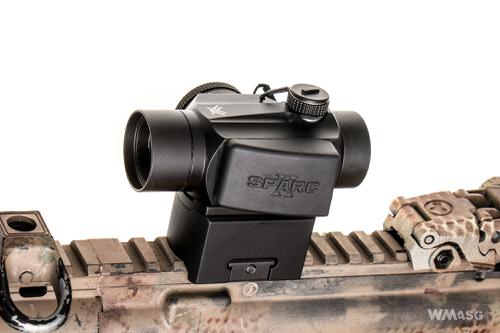
SPARC II (Speed Point Aiming for Rapid Combat) appeared on the market in 2014 and since then has gained recognition of many shooters as a relatively cheap, universal and durable rifle sight. Is this a well deserved opinion? We will try to find out.
The design
We will divulge here into analyzing from which aluminum alloy the housing is made, because everyone can read the sight's specification, so let us talk about things that may interest us when it comes to its design.

In the box contains the sight, flip-up covers for the front and rear lens, a torx wrench, a spare battery, a cleaning cloth, two mounts (low and high), a spacer and two sets of screws for fixing them. It is the assembly and the spacers that make the SPARC II one of the most versatile sights on the market straight out of the box.

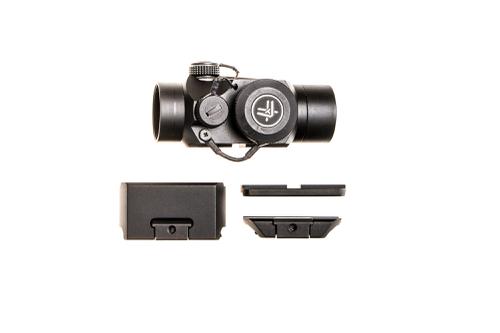
Using only the low mount or a 3 mm spacer, the collimator can be mounted on an AK carbine, a shotgun and any other weapon, where the mounting rail is located relatively high above the axis of the butt stock. Using the high assembly (37 mm high) the collimator ideally suited for HK416 carbines and replicas, where the mounting rail is a little higher due to the piston construction of this weapon. On AR-15 carbines, the collimator will have so-called "Absolute co-witness", which means that when aiming using iron sights and the collimator at once, the dot will be exactly in the center of the iron sights. Using the high assembly and a spacer (giving a total height of 40 mm), we will obtain the so-called "1/3 co-witness", the dot will be at the bottom of the iron sight (about 1/3 of its height). The advantages and disadvantages of one over the other could be a topic for a separate article, therefore adjusting the mounting height should be left to the user's preferences.
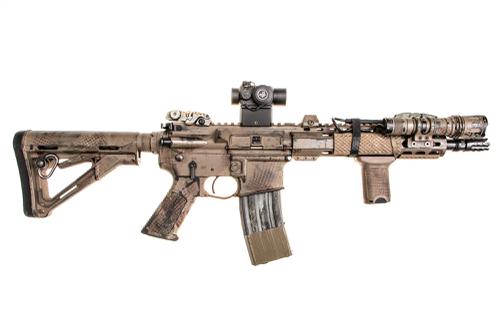
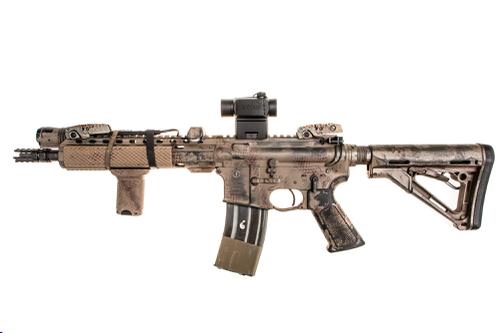
It should be noted that the SPARC II is compatible with the mounts made for the Aimpoint T-1, so in this matter the choice is very wide and if someone deems it necessary to find another mount, it is not a problem, but it can cost almost as much as sight itself.
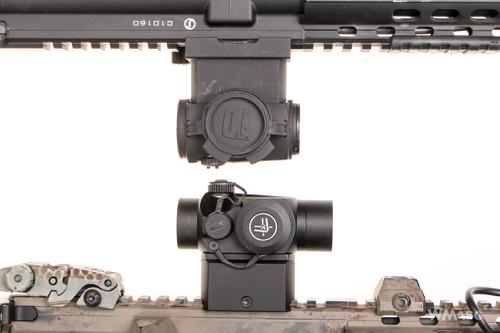
SPARC II is hard to classify. It is bigger than the Aimpoint T-1 / T-2, but smaller than e.g. the Comp M4 and, although its design is the closest to the T-1, its size is closest to the Trijicon MRO. SPARC II is not heavy (200 g with the high mount), and due to the relatively compact design, its weight is not felt on the weapon nor does it significantly change its balance.
The sight is operated using two buttons on the left side of the housing. SPARC I was operated with 4 buttons so we have a significant improvement in the ergonomics department. Pressing the button with the up arrow turns the sight on, increase the brightness of the dot, and holding it down for a min. of 4 seconds, turn the sight off. Pressing the button with the down arrow reduces the brightness of the dot. We have 10 degrees of brightness, the lowest 2 being compatible with night vision. Its that simple.
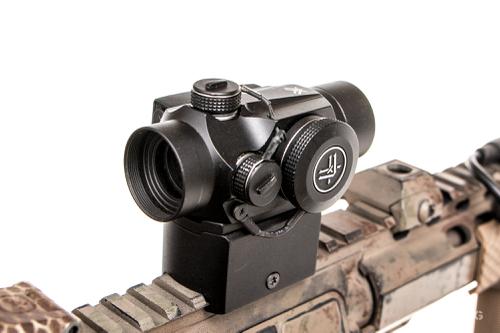
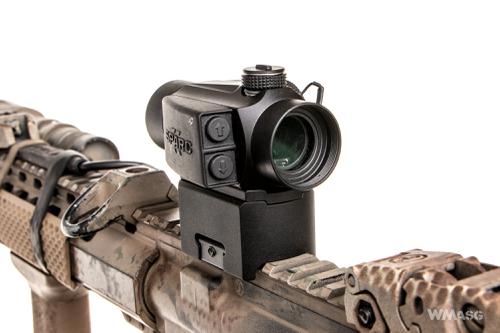
In addition, we have two screws, covered with threaded caps, used for zeroing in the sight. The outer sides of the cups can be used to make the adjustments. Each click means shifting the dot by 1 MOA (3 cm per 100 meters). Both the adjustment caps and the battery container have been secured against loss by means of a durable wire.
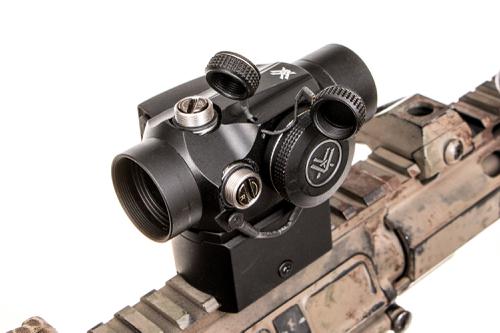
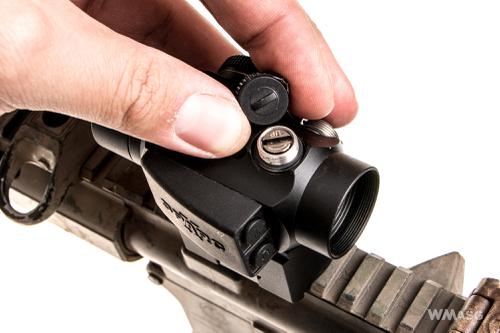
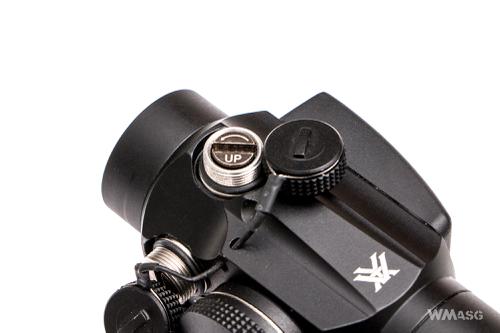
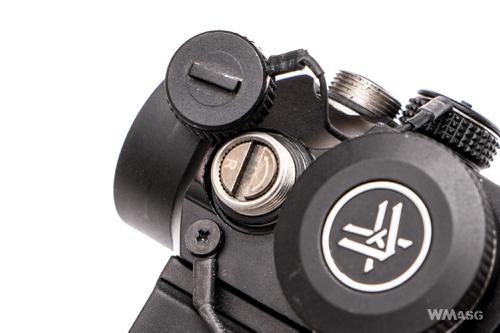
The target dot has a size of 2 MOA, which means that it covers an area of 6 cm at 100 meters (assuming the dot is perfectly round). While this is not important when shooting from a replica, it may be important when firing a real firearm.
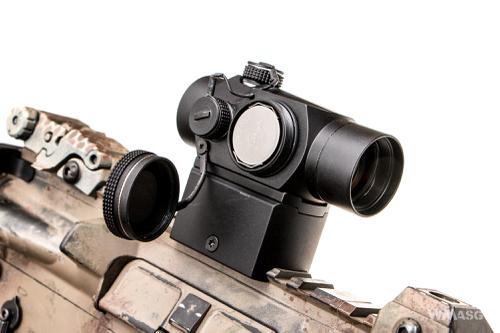
The sight is powered by a flat CR2032 battery, which is relatively easily available, and the manufacturer declares the sight's operating time on a single battery ranges from 5,000 hours (at the lowest setting) to 300 hours (at the highest setting). In addition, after 12 hours, the sight switches off automatically.
Using the sight
We mounted the SPRAC II on the Schmeisser Germany S4F carbine chambered for the .223 Rem cartridge and tested using the GGG 55 gr ammunition. We used the high assembly with a spacer giving the 1/3 co-witness. We secured the screws with a lock tight to make sure that nothing will move. We zeroed in the sight first at 25 and then at 100 meters, keeping a decent grouping. Any deviations for the grouping were due to the shooter's errors rather than the sight. These cups, which can be used to adjust the sight, are a rather emergency solution. Due to the fact that both were secured against loss by means of a durable and quite stiff wire, reversing them and using them to turn the adjustment screws presents some problems. However, this is a very practical solution when you do not have a small coin, a screwdriver or a spent casing.
The flip-up covers fulfill their function. The springs keep them in place and they do not dangle when the weapon the sight is on moves. It should be noted that they have a big influence on how the sight is perceived visually and it looks a little underwhelming without them. We removed the covers for testing so as not to damage them during our stress tests.


The first thing that catches the eye, when we look through the sight after mounting it, is its peripherals (the adjustment caps, the battery cover, the brightness adjustment panel), which occupy quite a large part of the field of view. Behind the brightness adjustment panel alone, at a distance of 60 m, an adult person can hide with ease (of course, if we close the eye that we do not for aiming). After installing the flip-up covers, the impression of looking through the keyhole is enhanced. However, this does not affect the functionality of the sight, it is about the the impression it makes. We will have a similar impression when looking through the Aimpoint T-1 or a Holosun from the micro series. It is less overwhelming there due to a more slim shape of the peripherals. Only the Trijicon MRO coped with this problem using two sizes of lenses at the front and back, but it comes with a slight distortion of the image and the echo effect.
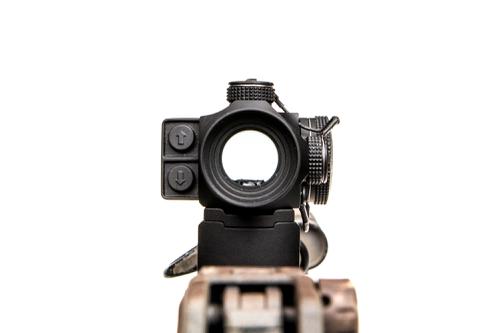
Placing the adjustment buttons in the place they are at can be considered a good design choice. They are easy to use, and the right-handed shooter will not have to take his hand off the pistol grip of the weapon to make the dot brighter or dimmer. In gloves, the clicks are definitely less perceptible (here the advantage of a knob stands out) and you have to push a few times before finding the right point on the button.
A 10-degree range of spot brightness adjustment seems to be sufficient, but at some point (somewhere between 5/6 degree) the brightness jump seems to be too big. At the 5th degree the spot is too dark and at the 6th the spot is too strong and the glow too intense. The dimmest setting seems to be insufficient. The dot is visible, but finding it takes a fraction of a second. It should be noted, however, that we tested it in extreme conditions, a sunny day, fresh snow, in direct sunlight. Except for extreme lighting conditions, the adjustment range is perfectly sufficient.


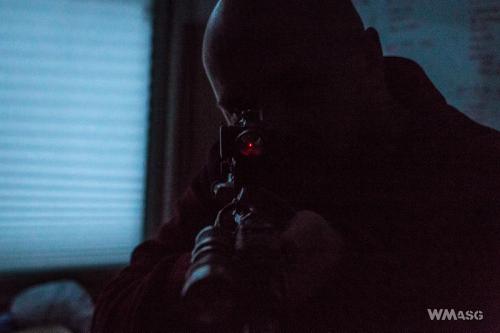
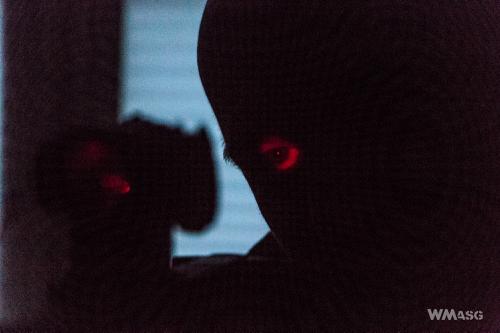
As for the quality and shape of the dot itself, depending on the degree of its brightness and the environmental conditions, I reminded me a regular dot or a dash. While it does not make a difference when aiming fast short and medium distances, putting a more precise shot at a greater distance may not be so easy. A lot of things can affect the deformation of the sight's dot (from the possible user's eye defect to the characteristics of a particular sight we own), but this does not affect its use of regular shooting practices.
The manufacturer declares a minimal parallax effect (i.e., shifting the aiming point if we do not aim through the center of the viewfinder) and it actually is minimal but noticeable. A nod to the manufacturer that he did not try to tell people otherwise.
A thing to which people who shoot a lot in the dark or in conditions of limited visibility will pay attention to is that the emitter of the dot is aimed directly at the front lens and its light is quite visible which may reveal our position. This effect occurs in almost all types of sights of this kind, but in some it is more and in some it is less noticeable. SPARC II get a score of 5/10 from us in this respect.
The last thing about the dot. When changing targets quickly, while looking through the sight, we had the impression that the dot was flashing (like a screen with a too slow refresh rate). While this does not affect the accuracy and operation of the sight, it is an impression worth mentioning, as it does not appear in "high-end" collimator sights.
Despite strenuous attempts, we were not able to discharge the battery and from the life span declared by the manufacturer, ranging between 300 and 5000 hours, one should draw a reasonable conclusion that a battery will last for about 1000 hours with the setting at the level of 5 or 6. This is a very reasonable result considering that the EOTech 552 has an average battery life of about 600 hours.
The Mini Torture Test
We tested SPARC at a temperature of + 1°C to -5°C, so in rather unfavorable conditions. We poured water on the sight mounted on a weapon, hit it against a table several times and threw it on the ground. All that did not affect its operation nor its dot position.
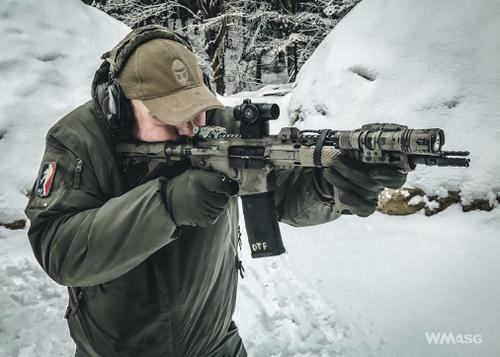
We did not bother freezing, smoking or shooting at it because it was a waste of time, and the measurability of such these tests leaves much to be desired, although they look very spectacular.
Summary
As an extension of our passion, most of us plan to have a firearm and start practicing shooting as a sport. For such people, the SPARC II is a great investment. It is located in the high budget range of sights we can buy for a replica, but at the same time we have a sight, which we can easily mount on a firearm.
SPARC suffers from several drawbacks like quite a large size, a somewhat distorted dot, an average battery life, but it is these things that determine its costs at around 1/3 of a price of a "top shelf" sights.
So if you have the right budget and plan to buy a firearm in the future, SPARC II is a very good idea. If you do not plan to change the type of ammunition you use from 6 mm to 5.56 mm, but you have the right budget, you will buy a sight that will be perfect for a replica and will offer you more than a Chinese copy of the T-1 or the MRO.
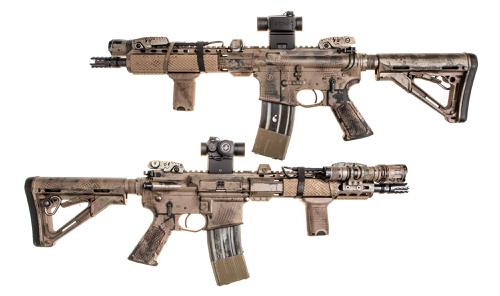
+ not too heavy (with the high assembly its about 200 g)
+ great configuration options for mounting and matching it to the type of weapon you are using
+ flip-up covers included
+ decent battery life
+ ergonomic operation (2 buttons)
+ durability
- size of the peripherals
- problem with the shape or brightness of the dot under certain conditions and settings (may not be present in every unit)
- the brightest setting may not be enough on a very bright day
- a large amount of light released by the emitter, visible from the front
- quite difficult handling of the buttons when using gloves
We tested the sight thanks to the courtesy of Kolba.pl

The test was done in cooperation with DTF Solutions





